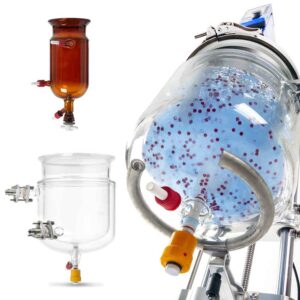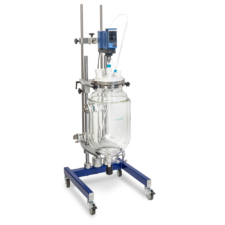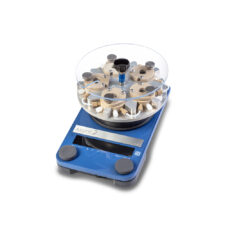Batch and flow reactions are two fundamentally different approaches to chemical processing. The question of whether a given reaction or synthesis should be carried out using a batch reactor or a flow reactor is often up for debate, with both methods offering advantages and disadvantages for certain types of reaction. Here, we give a quick rundown of flow vs. batch reactors and explore the different benefits they can bring to the lab.
What is a Batch Reactor?
Batch processing is an approach to chemical synthesis which would be familiar to bakers: Mix a certain amount of ingredients in a specific ratio, expose the whole lot to certain conditions (e.g., heat) for a certain period, then end the process.
In the lab, batch processes have traditionally been the “default” approach. Such processes run in cycles, with each cycle producing a batch of products that can then be moved to the next stage of processing or analysis.
Any vessel in which batch chemical reactions can be carried out is technically a batch reactor. However, the term “batch reactor” is sufficiently vague to avoid common usage in laboratory environments and instead tends to be reserved for the large impeller-driven tanks common in industrial processing.1 Common types of lab-scale batch reactors include pressure reactors, jacketed reactors, and other types of benchtop synthesis tools. Batch reactors are typically fitted with various attachments which enable a reaction to be monitored and controlled.
Benefits of Batch Reactors
One of the primary benefits of batch reactors is that the production of small batches is good for quality control. Running a synthesis in a small batch reactor enables the process to be trialled in small volume, analysed, and then modified if required. Batch reactors are also more common than flow reactors: this means they’re often cheaper to purchase and easier to use.
What is a Flow Reactor?
Continuous flow processing – also known as “Flow Chemistry” – is where reactions are carried out in a continuous stream. While Flow Chemistry has long been established in “scaled-up” industrial syntheses, the term has only been coined relatively recently to describe small-scale continuous chemical reactions in the lab.2
Flow reactors are generally microfluidic systems that use pumps and tubing to bring reagents together. Flow reactors typically also contain heating and mixing apparatus, often in the form of different “modules” that reagents are pumped through.
Benefits of Flow Reactors
Interest in Flow Chemistry has increased over the last 20 years, with benefits including more efficient mixing in multiphasic systems, enhanced temperature control, scale-up potential, and better alignment with “green chemistry” principles that relate to efficiency and safety.3–5 Low volumes of reagents mean temperatures can be precisely and accurately changed, and mixing can be carried out quicker than in batch reactors.
Flow and Batch Reactors from Asynt
At Asynt, we produce world-leading solutions for both batch and flow processing in the lab. From our DrySyn range of heating blocks, which offer an alternative to oil baths and heating mantles, to versatile modular flow reactors and accessories; we provide accurate, powerful, and reliable equipment suitable for any laboratory.
Are you interested in finding out more about our range of flow and batch reactors? Get in touch with a member of the Asynt team today.
References and Further Reading
- Morgenroth, E. & Wilderer, P. A. Sequencing Batch Reactor Technology: Concepts, Design and Experiences (Abridged). Water and Environment Journal 12, 314–320 (1998).
- Chemistry in flow systems II. https://www.beilstein-journals.org/bjoc/series/17.
- Plutschack, M. B., Pieber, B., Gilmore, K. & Seeberger, P. H. The Hitchhiker’s Guide to Flow Chemistry. Chem. Rev. 117, 11796–11893 (2017).
- Rogers, L. & F. Jensen, K. Continuous manufacturing – the Green Chemistry promise? Green Chemistry 21, 3481–3498 (2019).
- Anastas, P. & Nicolas Eghbali. Green Chemistry: Principles and Practice. Chem. Soc. Rev. 39, 301–312 (2010).








